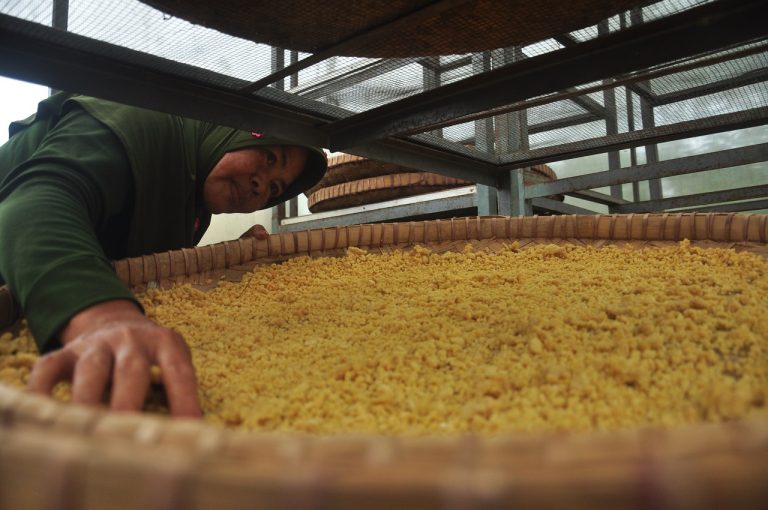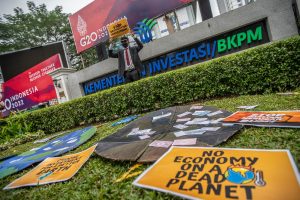Calling for stronger government backing for local food producers
by: Hartatik
Wonosobo – For local foods like cassava to gain recognition within academic and public spheres, Prof. Achmad Subagio emphasises the need for a dedicated strategy to ensure their continued relevance in society. This is particularly important among millennials, who now have easy access to a wide variety of foods from outside Indonesia.
The University of Jember professor, who has spent more than a decade researching cassava, believes that improving public food preferences is essential. To strengthen its value, Prof. Subagio said there is a need to expand the availability of cassava-based foods by empowering local food MSMEs. In particular, he highlights the importance of increasing the supply of cassava and its processed products as viable substitutes for staple foods.
“We need to reposition cassava as a prestigious food product. Not only that, but the cassava supply chain must also be improved so that upstream (farmers) have price certainty and distribution channels with the processing industry. This step requires cooperation and commitment from major stakeholders and the central government to make it happen,” he said.
He believes that there has been a mistake in food education for Indonesians, leading them to consume rice. It is not only a matter of price; there is also the perception that rice tastes better and is part of the lifestyle.
“So this is a matter of perception. We need to change the national perception of our food. If this is not done in a structured and systematic manner, it will be difficult for us. This must be done by the government,” he said.
Subagio, known as the ‘cassava professor’, also sees many advantages of cassava. Because it is gluten free, cassava is good for people with autism and allergies. Cassava is also rich in fibre, which is good for people with diabetes.
A similar opinion was expressed by Prof. Fransiska Rungkat, Professor of Food Science at IPB University. She believes that if rice can be replaced with just 20 per cent cassava, it can help reduce rice dependency and overcome food security issues. Moreover, cassava is rich in vitamins and minerals. It also contains soluble fiber that contains beta glucan and has high anti-cancer activity.
Considering the potential of cassava as a substitute source of carbohydrates for rice, the opportunities are enormous. In fact, Indonesia is currently the fourth largest cassava producer in the world.
Director of Food Consumption Diversity at the National Food Agency (NFA), Rinna Syawal, revealed that the population’s food consumption pattern in 2023 for cassava is still low, at 9.7 kg/capita/year.
“Cassava is a tuber crop that has the potential to support food diversity, especially since people in various regions of Indonesia have made cassava their staple food.”
Rinna added that the NFA has made several efforts to promote the potential of cassava in diversifying local food consumption. These include the implementation of Presidential Regulation No. 81 of 2024 on Food Diversification Based on Local Resource Potential, the promotion of B2SA (Diverse, Nutritious, Balanced, and Safe) from local foods, advocating for local governments to utilize local foods, collaborating with professional associations and local food businesses, and providing assistance to local food MSMEs (Micro, Small, and Medium Enterprises).
“Consuming local food is not only about fulfilling nutritional needs, but also driving the economy, preserving culture, being environmentally friendly, and, last but not least, achieving national food self-sufficiency,” she added.
This regulation should serve as a guideline for local governments in implementing regional food security strategies to support national food sovereignty. It is also crucial for the Free Nutritious Meals (MBG) program to optimize the use of local food in line with the implementation of Presidential Regulation No. 81/2024.
Unfortunately, however, the implementation of this regulation has not been entirely optimal. This is because, in the Head of the National Nutrition Agency (BGN) Decree No. 63 of 2025 concerning Technical Guidelines for the Implementation of Government Assistance for the Free Nutritious Meals Program for the 2025 Fiscal Year, each Nutrition Fulfillment Service Unit (SPPG) is required to use fortified local food ingredients in accordance with the characteristics of their region.
“In agricultural areas such as Central Java and East Java, the main sources of carbohydrates are rice and green vegetables, while in NTT and Sulawesi, corn, sweet potatoes, and sago are the main staples of the daily diet,” Khairul Hidayati, BGN Head of the Legal and Public Relations Bureau explained.
This policy has certainly further eroded the tradition of consuming leye rice or cassava-based foods in Central Java. This situation has been exacerbated by the MBG project, through which the government appears to be positioning food as a populist commodity and political vehicle.
The program, which is supposed to guarantee nutrition for the people, is actually managed centrally without meaningful public participation. It is aimed at the most marginalised groups and does not favour local food producers.
“We urge the government to be more supportive of small food producers and strengthen local food systems, which have proven to be more sustainable,” said FIAN Indonesia National Coordinator Marthin Hadiwinata at a forum commemorating World Food Day 2025 and declaring the formation of the Anti-Profit Food Coalition on Thursday, October 16.
Meanwhile, Environmental and Forestry Observer Irwan Fecho said that regions have local food sources that have emerged from long interactions between humans and nature, becoming part of a culture that has been passed down from generation to generation. The National Food Agency (Bapanas) itself notes that Indonesia has around 945 types of local food, 77 of which are sources of carbohydrates.
“These figures show that every region in Indonesia actually has its own ‘food barn’,” he said.
Even so, this diversity is slowly being marginalised. People’s consumption patterns are becoming more uniform, giving rise to the superiority of rice and imported commodities such as wheat. Bapanas notes that 97 per cent of Indonesia’s population now depends on rice as their main source of carbohydrates.
This dependence makes the food system vulnerable to climate crises and global turmoil, eroding the diversity of local foods that form part of the nation’s identity. This is particularly true now that the government is rolling out the MBG policy, which some people understand solely as a nutritional intervention to combat stunting.
Upon closer examination, MBG has great potential as a strategic lever for the transformation of our food system.
In addition, if designed based on local potential and wisdom, the MBG program can play two important roles at once. First, it provides balanced nutrition for Indonesian children. Second, it drives the local food ecosystem, empowering farmers, fishermen, and small businesses in the region.
By involving them as key suppliers, MBG can create a stable market, increase farmers’ incomes, and revive food diversification in the archipelago. (Hartatik)
Read the previous parts:
Part 1: https://tanahair.net/from-villages-to-social-media-how-millennials-preserve-nasi-leye-1-3/
Part 2: https://tanahair.net/from-villages-to-social-media-how-millennials-preserve-nasi-leye-2-3/
This coverage is part of the “Journalist Fellowship and Mentorship Program for Sustainable Food System 2025” scholarship supported by the Sustainable Food System Coalition (KSPL) in collaboration with AJI Jakarta.
Banner photo: Siti Maryam drying flour made from yellow sweet potatoes to be used as an ingredient in instant tiwul at her home in Lipursari Village, Leksono District, Wonosobo Regency. (Hartatik)















